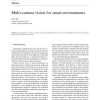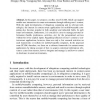182
Voted
ICOM
2011
14 years 3 months ago
2011
In this paper we describe an implicit user interface for smart environment control: We make our system guess how to assist the user(s) proactively. Our controller is based on two ...
112
Voted
PERCOM
2011
ACM
14 years 4 months ago
2011
ACM
—The need to prolong the ability for older adults to live at home independently has become an important area of smart environment research. In this proposal, we demonstrate a web...
125
Voted
IHI
2010
14 years 7 months ago
2010
One of the most common functions of smart environments is to monitor and assist older adults with their activities of daily living. Activity recognition is a key component in this...
103
click to vote
JAISE
2011
14 years 7 months ago
2011
On September 21, 2010, the author successfully defended her Ph.D. thesis entitled Multi-Camera Vision for Smart Environments at Stanford University.
PERCOM
2010
ACM
14 years 10 months ago
2010
ACM
—The increasing number of interactive products in our environment leads to an accession of interaction between products and users. Nowadays, this interaction is described with di...
112
click to vote
PERCOM
2010
ACM
14 years 10 months ago
2010
ACM
— Enriched with more and more intelligent devices modern homes rapidly transform into smart environments. Their growing capabilities enable the implementation of a new generation...
112
Voted
WOA
2003
15 years 1 months ago
2003
— Pervasive and ubiquitous computing is enabling the implementation of “smart environments”, i.e., environments where applications support and enhance the abilities of their ...
EUC
2006
Springer
15 years 4 months ago
2006
Springer
In this paper, we propose a toolkit, wear-UCAM, which can support mobile user interactions in smart environments through utilizing user's context. With the rapid developments ...
107
click to vote
ARCS
2004
Springer
15 years 5 months ago
2004
Springer
Abstract. The severe resource restrictions of computer-augmented everyday artifacts imply substantial problems for the design of applications in smart environments. Some of these p...
ROBOCOMM
2007
IEEE
15 years 6 months ago
2007
IEEE
—The vision of network robot systems involves robots embedded in smart environments, with which they can collaborate and communicate. In such systems, robots have access to many ...


